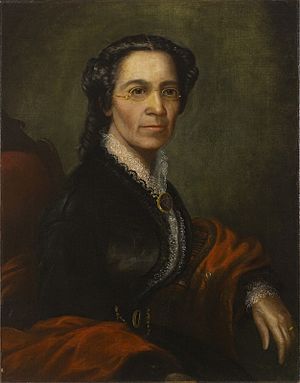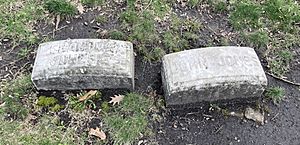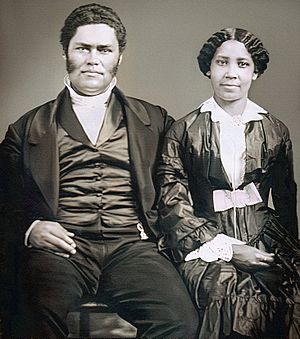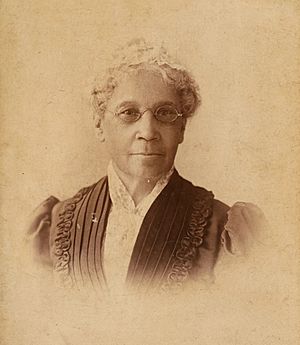Mary Jane Richardson Jones facts for kids
Quick facts for kids
Mary Jane Richardson Jones
|
|
|---|---|

Mary Richardson Jones c. 1865
|
|
| Born |
Mary Jane Richardson
1819 |
| Died | December 26, 1909 (age 89–90) Chicago, Illinois, US
|
| Occupation | Activist |
| Spouse(s) | John Jones |
| Children | 1 |
Mary Jane Richardson Jones (1819 – December 26, 1909) was an important American activist. She worked to end slavery, helped people in need (philanthropist), and fought for women's right to vote (suffragist).
Born in Tennessee to parents who were not enslaved, Mary and her family moved to Illinois when she was a teenager. With her husband, John Jones, she became a leading African-American figure in early Chicago. Their home was a busy center for people working to end slavery before the American Civil War. They helped hundreds of people escape slavery through the Underground Railroad.
After her husband died in 1879, Mary Jones kept supporting African-American civil rights and progress in Chicago. She also became a strong supporter of women's voting rights. Jones was active in the women's club movement. She guided and inspired younger black leaders like Fannie Barrier Williams and Ida B. Wells. Historian Wanda A. Hendricks called her a rich "aristocratic matriarch," meaning she was a respected leader of Chicago's black elite for many years.
Contents
Early Life and Moving to Chicago
Mary Jane Richardson was born in 1819 in Memphis, Tennessee. Her family was free, not enslaved. Her father, Elijah Richardson, was a blacksmith, and her mother, Diza, was a homemaker. Mary was one of nine children. Authors Arna Bontemps and Jack Conroy described her as a beautiful woman.
In the 1830s, Mary moved with her family to Alton in Madison County, Illinois.
Marriage and New Home
In 1841, Mary married John Jones and took his last name. John was also a free black man from North Carolina. They had met in Tennessee, and he moved to Alton to be with her. Their daughter, Lavinia, was born in 1843. Because free black people sometimes had their freedom questioned, the couple made sure to get new freedom papers in 1844.
The young family moved to Chicago in March 1845. Chicago was a new city, and they were drawn to its strong anti-slavery movement. On their journey, they were stopped because people thought they might be runaway slaves. Luckily, their stagecoach driver helped them get free.
They arrived in Chicago with very little money. John started a tailoring business, which became very successful. By 1850, they could buy their own home. Even though both Mary and John could not read or write when they arrived, they quickly taught themselves. They believed that reading was key to being truly free.
Fighting for Freedom in Chicago
The Joneses became important members of Chicago's small African-American community. Mary, along with three other women, became a leader in the African Methodist Episcopal church at Quinn Chapel. They made the church a key stop on the Underground Railroad. The Jones family also joined the Liberty Party, which worked to end slavery. Their home became Chicago's second official stop on the Underground Railroad.
While John's business grew, Mary managed their home as a center for black activism. She helped organize protests against unfair laws like the Black Codes and the Fugitive Slave Act. These laws limited the rights of black people and made it easier to capture runaway slaves.
Helping the Underground Railroad
Their friends included famous abolitionists like Frederick Douglass. Douglass even introduced them to John Brown. Brown and his friends stayed with the Joneses on their way to their famous raid on Harpers Ferry. Mary gave them new clothes. Even though the Joneses were against slavery, they did not support Brown's violent plans.
Mary and John helped hundreds of enslaved people escape north to Canada. This was illegal at the time. Mary would stand guard during meetings of abolitionists. Her daughter, Lavinia, remembered her mother personally putting people onto trains heading north. This happened even while slave catchers watched, kept away by anti-slavery crowds. Mary kept in touch with many of the people she helped, creating a network of support.
In 1861, the Joneses helped start Olivet Baptist Church. This church had the first library open to black people in Chicago. Mary and three other women also created an aid group called Workers for the King through the church in 1871. During the Civil War (1861-1865), Mary helped recruit soldiers for the United States Colored Troops. With other activists, she helped found the Chicago Colored Ladies Freeman's Aid Society. This group gave direct help to former slaves and was a place for political action.
Later Life and Continued Activism
Mary Jones was a woman with strong beliefs. She continued to fight for equal rights and integration (meaning black and white people living and working together) after the Civil War ended. In 1867, a journalist named Theodore Tilton planned to give a lecture in Chicago. Mary wrote to him to warn him that the audience would be separated by race. Tilton was upset by this. He successfully pushed the venue to allow mixed seating for his talk. He even gave tickets to Mary and read her letter to the audience.
In 1871, John Jones was elected as a Cook County Commissioner. He was the first African-American to be elected to public office in Illinois. That same year, the Great Chicago Fire destroyed the Jones family home and John's business. The family was able to rebuild, creating a new home and restarting John's tailoring business.
A Wealthy Widow
After John died in 1879, Mary Jones became very wealthy. Her husband's estate was worth a lot of money, making him one of Chicago's richest men. John's tailoring business was taken over by a family friend, Lloyd Garrison Wheeler.
Mary moved to a grand new home that showed her wealth and high standing in the city. Historian Christopher Robert Reed says she was seen as the center of black society in Chicago until the 1890s. Historian Wanda A. Hendricks called her a wealthy "aristocratic matriarch," leading Chicago's black elite for two decades.
Supporting Younger Leaders
Mary Jones used her wealth to help others and support activism. She gave a lot of money to Hull House and the Phillis Wheatley Club in Chicago. Her financial help allowed the Wheatley Home for Girls to be founded in 1908. This home supported young women who had just moved from rural areas.
Mary was not quick to support women's right to vote. She thought that famous African-American women like Edmonia Lewis had not pushed for it. She believed women should do all they could do in other ways. But once she decided to support voting rights, she hosted important leaders like Susan B. Anthony and Carrie Chapman Catt at her home for meetings.
Jones also supported younger black Chicagoans like Daniel Hale Williams. She gave Hale Williams a place to stay and paid for his medical education. In return, he helped with household tasks. When he started his own medical practice, Mary was one of his first patients. Later, in 1891, when he founded Provident Hospital as a non-segregated hospital, she gave a large donation.

Mary emphasized moral and social improvement. She told a Chicago Tribune reporter in 1888 that "we want more justice to women and more virtue among men." She was active in the women's club movement. In 1894, she was the first chair of Ida B. Wells's new club, helping to recruit members and giving it her respected name. With Fannie Barrier Williams, Jones ran the women's section of the Prudence Crandall Literary Club. This was an important place for black activism and feminism in Chicago. She guided a new generation of black women leaders, including Barrier Williams, Wells, and Elizabeth Lindsay Davis.
Mary Jones died on December 26, 1909. The Chicago Defender newspaper reported that she was "loved and admired by everyone." She is buried next to her husband at Chicago's Graceland Cemetery. Her tombstone reads "Grandma Jonesie." In 2005, a Chicago park was named in her honor.




